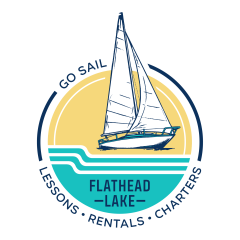History of Flathead Lake
At Go Sail Montana, we are honored to enjoy the beauty of Flathead Lake every day. The breathtaking landscape we see now is the result of fascinating natural forces and human intervention, and Flathead Lake’s history is part of its charm. This timeline of the history of Flathead Lake will take you through each phase of life that the lake has seen up until now!
The Ice Age
In the last ice age (12,000 to 15,000 years ago), massive glaciers moving across the land carved deep depressions in the earth. As temperatures rose, the glaciers retreated and melted, filling the basin of what is now Flathead Lake with water.
1855: Treaty of Hellgate
The first humans to settle in northwestern Montana were Native Americans. Flathead Lake is named after the Salish Indians, who were mistakenly called Flathead Indians. The Kootenai, Pend d’Oreilles, and Kalispel tribes also made up the population. When European settlers arrived in the 1820s, the social and economic relationships between the tribes changed, stirring conflict. As a result, the US government created the Treaty of Hellgate, which established the Flathead Indian Reservation, surrounding most of Flathead Lake.
1904-1909: US Development
To encourage Native peoples to adopt European-American practices, the US Congress approved the Flathead Allotment Act (1904) and the Flathead Irrigation Project (1908). The former granted the Salish Indians allotments of land to promote subsistence farming. The latter provided irrigation water to those allotments. By this time, transport by water had become essential to the development of Flathead Lake’s trade, so in 1909, the federal government completed a project to deepen Polson Harbor so that boats could dock and travel more easily.
1930: The Kerr Dam
In order to generate hydroelectric power, construction of the Kerr Dam began in 1930. The dam, which raised the lake’s water level by 10 feet, also provides irrigation water to the region and prevents flooding. Because the dam is within the boundaries of the Flathead Indian Reservation, it was part-owned by the Confederated Salish and Kootenai Tribes. In 2015, the tribes bought out ownership of the dam and renamed it the Seli’š Ksanka Qlispe’ Dam.
2000: River to Lake Initiative
The Flathead River to Lake Initiative focuses on preserving the ecological integrity of Flathead Lake, its tributaries, and its watershed. This initiative involves a broad collaboration of stakeholders, including community members, landowners, government agencies, and scientists. Its goal is to promote smart development and safeguard water quality and native species to ensure that the resources and natural beauty of the area can be enjoyed by future generations.
Flathead Lake Today
Thanks to the contributions of conservationists, engineers, and native tribes over the last centuries, Flathead Lake still boasts some of the clearest water and most unspoiled nature in North America. It is an ideal location to learn to sail because its temperatures are mild in summer, and its winds are consistent. Six state parks also surround the lake’s borders. We can’t wait to share this special place with you when you sign up for sailing courses!
